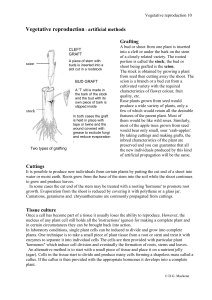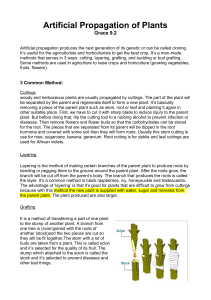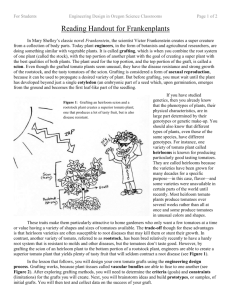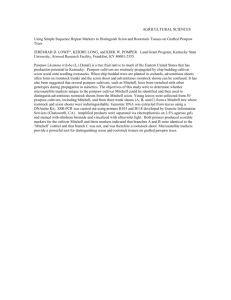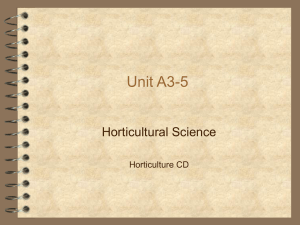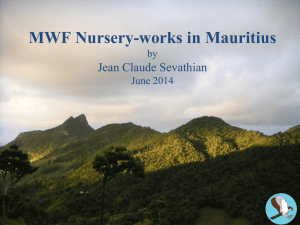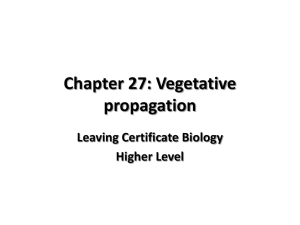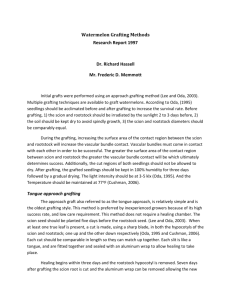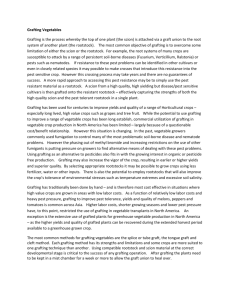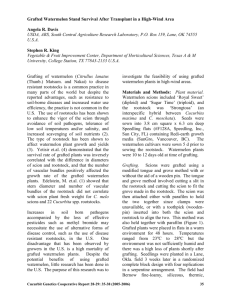revised propagation and nursery management
advertisement
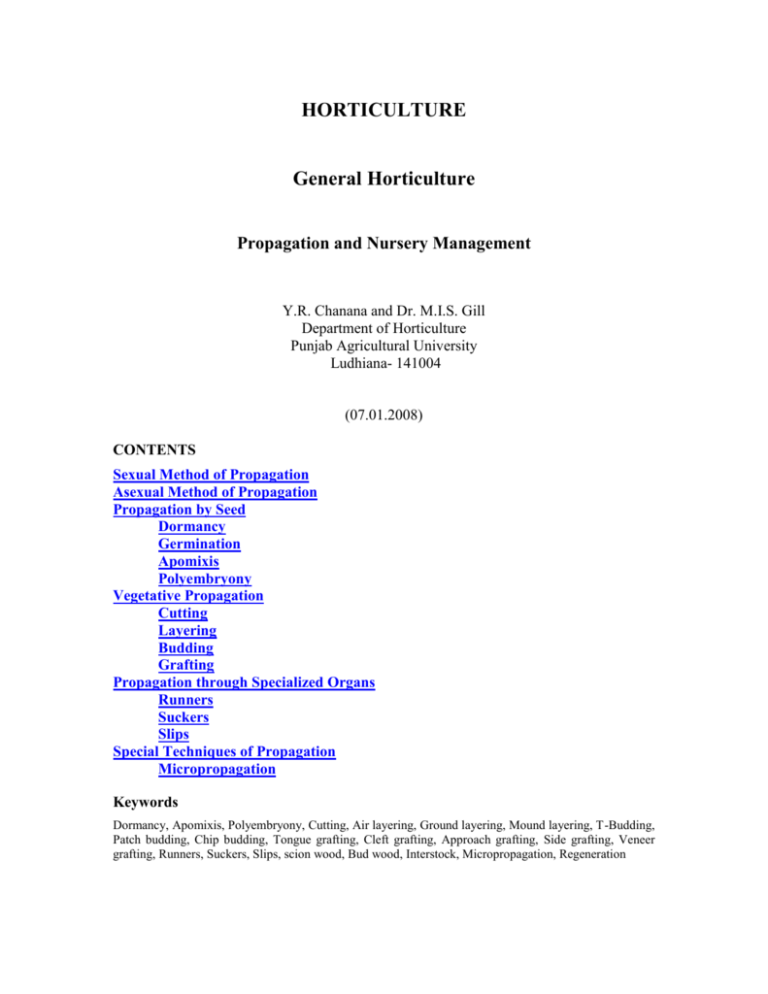
HORTICULTURE General Horticulture Propagation and Nursery Management Y.R. Chanana and Dr. M.I.S. Gill Department of Horticulture Punjab Agricultural University Ludhiana- 141004 (07.01.2008) CONTENTS Sexual Method of Propagation Asexual Method of Propagation Propagation by Seed Dormancy Germination Apomixis Polyembryony Vegetative Propagation Cutting Layering Budding Grafting Propagation through Specialized Organs Runners Suckers Slips Special Techniques of Propagation Micropropagation Keywords Dormancy, Apomixis, Polyembryony, Cutting, Air layering, Ground layering, Mound layering, T-Budding, Patch budding, Chip budding, Tongue grafting, Cleft grafting, Approach grafting, Side grafting, Veneer grafting, Runners, Suckers, Slips, scion wood, Bud wood, Interstock, Micropropagation, Regeneration The method of production of more than one plant from the mother plant or the tissue over a specific time period is termed as plant propagation. The production of true to type progeny from the mother plant is the prime objective of propagation. Plant propagation has been a useful tool since centuries, which has made possible the generations to pass through and sustain production especially for fruit plants since time immoral. Plant propagation depends on the plant species, variety, method of propagation, climatic and growth conditions. Methods Plant propagation is primarily done by conventional methods, which include sexual and asexual methods. However, in the recent past plant propagation through biotechnological applications have made great contributions towards mass scale production of plants. The conventional and the recent biotechnological approaches in fruit plant propagation will be discussed in detail. Sexual Method of Propagation: In this method the plants are raised from seeds. Advantages: For evolution of new varieties through breeding, the hybrids are raised from seed. 1. In some fruit plants like papaya, this is the most popular method of propagation. 2. 3. Seed propagated rootstocks are hardy and develop better root system. Viruses don’t transmit through seeds, thus mostly the seedlings are free from virus diseases. 4. Occurrence of polyembryony (more than one embryo in seed) in citrus and mango leads to the development of uniform seedlings as in asexual method. Disadvantages 1. Seedlings have a long juvenile period and come into bearing later as compared to asexually raised plants. 2. Due to segregation of characters, the progeny is not true-to-type. 3. It is not economical to handle larger trees, as less number of trees can be accommodated per unit area and the cultural operations are difficult. Asexual Method of Propagation: In this method of propagation the plants are obtained from a vegetative portion of the mother plant instead of seeds. Advantages 1. In some fruit plants like banana, which do not bear seeds, this is the only method of propagation. 2. The plants are generally true-to-type, uniform in growth, yielding capacity and fruit quality. 3. Have short juvenile phase, thus come into bearing earlier than seedling plants. 4. The advantages of rootstocks can be obtained by budding or grafting susceptible varieties on resistant/ tolerant rootstocks. 5. Plants have restricted growth, thus cultural practices and harvesting are easy. Disadvantages 1. 2. 3. New variety cannot be evolved by this method. Such plants are not so vigorous and long-lived as the seedling trees. Germplasm conservation requires lot of space and is expensive as compared to storage of seeds. Propagation by Seed In fruit plants the propagation through seed is primarily done to raise rootstocks required for grafted plants. While some fruit plants like papaya are conventionally seed propagated. Dormancy: The dormancy in seeds might be due to hard seed coat, impermeability to water and gases, physiological immaturity of embryo, deficiency of some endogenous growth promoters or excess of endogenous growth inhibitors. Different methods like Stratification, scarification, and chemical treatment are used for breaking dormancy in seed to improve germination. Stratification consists of keeping seeds at low temperature (around 70C) by placing them in alternate layers of moist sand. While, in scarification the seeds are either treated with concentrated acid (acid scarification) or the seed coat is weakened mechanically, so as to make it permeable to water and gasses. In other instances, seeds can be pre-treated with some chemicals like thiourea or potassium nitrate to improve seed germination. Soaking seeds in water also overcome seed dormancy, if it is primarily due to endogenous growth inhibitors, which leach due to prolonged soaking of seeds. Germination: Germination refers to the emergence of a new plant from the mature seed. In other words, the activation of metabolic machinery of the embryo leading to the emergence of a new seedling plant is known as germination. For the germination to be initiated, the seed must be viable, that is, the embryo must be alive and capable of germination and the environmental conditions must be appropriate. Seed germination involves different phases of germination. These phases are characterized by a rapid increase in water uptake during the imbibation phase followed by a period where there is little water uptake called the lag phase. During the third phase, there is increase in fresh weight of seed, which leads to the emergence of roots. Apomixis: This is a natural mechanism during which vegetative embryo is produced instead of sexual or zygotic embryo. In other words, the apomixis occurs when an embryo is produced from a single cell of the saprophyte and does not develop from fertilization of two gametes. The seedlings produced are thus true to type and vigorous as compared to those produced through sexual means. Some species or individuals produce only apomictic embryos and are know as obligate apomicts. While other produces both apomictic and zygotic embryos are known as facultative apomicts, which occur in citrus. Polyembryony: Polyembryony, as the name indicates refers to the seeds having more than one embryo in the seed. One of the embryos arises from the union of male and female gametes and is called gametic or sexual embryo, whereas the others are produced by simple mitotic division of cells of nucellus without the help of male gamete in their formation. The phenomenon of nucellar embryo is of common occurrence in citrus and mango. In general, the nucellar seedlings are identified or in other words the zygotic seedlings are rouged out of nursery in step-by-step approach. In this method, the majority of the seedlings which fall within one vigour group and are more or less of the same size are considered to be nucellar. Others which are either too small or too tall than the commonly prevailing type are discarded and considered to be off type or zygotic. To eliminate gametic seedlings, first rouging should be done when they are about 10 to 20 cm tall and ready for transplanting in the nursery. The second rouging should be done at time of budding, while third and final rouging should be done at time of selecting budded plants for transplanting in the field. Vegetative Propagation The propagation of plants by the method other than sexual propagation is referred as vegetative or asexual propagation. It involves no change in genetic makeup of the new plant. All the characteristics of the parent plant are reproduced in the daughter plant due to exact duplication of chromosomes during cell division. Thus, the plants are true-to type in growth, ripening, yield and fruit quality. Methods There are different methods, which can be used for commercial multiplication of various fruit plants. These include cutting, layering, budding and grafting. Cutting: It is the method of propagating fruit plants in which the part of a plant (generally stem) having at least few buds, when detached from parent plant and placed under favorable conditions develop into a complete plant resembling in all characteristics to the parent from which it was taken. This method is commonly used in plants, which root easily and readily, thus, multiplication of plants is very quick and cheap. The fruit plants like phalsa, baramasi lemon and grapes are commercially propagated by cuttings. The hardwood cuttings are the common method of propagation, which are prepared from fully mature tissues. Round cuttings (Plate 1a) are preferred over angular immature cuttings (Plate 1b). The shoots of about one year old or more can easily be used for preparing hardwood cuttings. In case of decidous fruit plants such as grape, pomegranate, phalsa and fig the cuttings are made after pruning. While in evergreen fruit plants like baramasi lemon, the cuttings can be prepared during the spring (February –March) and rainy season (August-September). Generally the cuttings of 15-20 cm length and having 3-5 buds are made. The lower cut is given in a slanting manner just below the bud to increase the absorption of nutrients. The upper cut is given at a right angle to reduce the size of the wound and as far as possible away from then upper bud to avoid its drying. After the cuttings are prepared they should be allowed to dry. These cuttings are usually tied in small bundles (20-25 cuttings) and buried in moist soil/sand for a certain period for healing of wounds, which is known as callusing. a b Plate 1: Cuttings from evergreen (a. Round cuttings & b. Angular cuttings) and deciduous plants. Layering: Layering is a method of vegetative propagation, in which roots are induced on the shoots while they are still attached to the mother plants. This is a alternate method of propagation in fruit plants which do not root easily when detached from the mother plants. Most commonly used methods of layering are air layering, ground and mound layering. 1. Air layering: As name refers, in this method the layering is done in air. To be more precise the rooting is done on the shoot itself when it is still attached to the mother plant. In this method one year old, healthy and straight shoot is selected and ring of bark (Plate 2) measuring about 2.5 cm just below a bud is removed. Moist sphagnum moss is placed around this portion and is wrapped with a polythene strip. It is light in weight, and has a very high water holding capacity. If sphagnum moss is not available, any other material, which can retain moisture for long period of time, can be used for this purpose. The polythene covering does not allow the moisture to come out but permit gas exchange. Moreover the layers need not be watered afterwards, which saves a considerable labour. This method of layering is also known as goottee method. Air layering can be practiced during February–March and July-August in guava, litchi, sapota, loquat etc. After a few weeks the roots are developed which are visible through the polythene covering. Then a half way cut should be given to the rooted layers on the parent branch at least 15 days prior to their permanent removal from the mother plant. At the time of separation, a few leaves or small shoot is retained. It is also advisable to plant these rooted layers in nursery for close attention than to plant them directly in field. These layers can be planted in the fields during the following year in February or September–October. a b Plate 2: Steps showing removal (a) of outer bark of shoot, covering (b) with moss grass, wrapping with polythene & tying ends of polythene with rope. 2. Ground layering: In this method, a branch of plant, which is near the ground, is chosen and a ring of bark about 2.5 cm is diameter is removed just below the bud. This branch is then bended and buried in soil when still attached to the mother plant. The soil is regularly watered to keep it moist. Within a few weeks, the roots are formed and new plant is separated from the mother plant. Separation should be done in such a way that the roots formed also go with the detached plant. These new plants should preferably be planted in pots or nursery rows for development of better root system and shoot system before planting in the fields. This method is commonly followed for propagation of baramasi lemon. 3. Mound layering: In this method, plant is headed back either in February or in July. The new shoots come out during April and September, from ground level. A ring of bark is removed from these shoots and they are covered with moist soil. The rooted stools of April stooling are separated during rainy season and those of August are removed in the following spring. These stools, after separating from the parent plant are planted in the nursery fields. This method is also known as stool layering and is used for propagation of guava and apple rootstocks. Budding: Budding is a method in which only one bud is inserted in the rootstock. This method is very easy and fast. This method saves budwood as compared to grafting. As soon as the bark starts slipping both on the stock and scion, this is considered to be the optimum time for budding. This shows that the cambium, which is the tissue responsible for union, is active. This method is generally employed during spring and rainy season. The common methods of budding are T-budding, patch budding, and chip budding. 1. T-Budding: This is also known as shield budding. A horizontal cut about 1/3rd the distance around the stock (Plate 3) is given on the stock 15-20cm above then ground level. Another vertical cut 2-3 cm in length is made down from the middle of the horizontal cut and flaps of the bark are loosened with ivory end of the budding knife to receive the bud. After the ‘T’ has been made in the stock the bud is removed from the bud stick. To remove the shield of bark containing the bud, a slicing cut is started at a point on the bud stick about 1.25 cm below the bud, continuing underneath about 2.5 cm above the bud. A second horizontal cut is then made 1.25 to 2 cm above the bud, thus permitting the removal of the shield piece. The shield is removed along with a very thin slice of wood. The shield is then pushed under the two raised flaps of bark until its upper horizontal cut matches the same cut on the stock. The shield should fix properly in place, well covered by the two flaps of bark, but the bud itself exposed. The bud union should be wrapped with polythene strip to hold the two components firmly together until the union is completed. T budding can be performed at any time of the year provided cell sap flows freely. a b Plate 3: Steps showing T-budding (a. removal of bud & b. fixing in rootstock and tying with polythene strip) and successful graft) In most fruit trees it is performed either in the spring (March-April) or in rainy season (July-September) period. This is the most common method of propagation of citrus plants. 2. Patch Budding: This type of budding is quite successful in guava and it gives 60 to70 percent success during May and June. Freshly cut angular bud-wood from current season’s growth should be used as scion. A rectangular or square patch or piece of bark about 1.0-1.5 cm broad and 2.5 cm long is removed from the rootstock (Plate 4) at about 15 to 20 cm from ground level. A similar patch with a bud on it is removed from the bud stick taking care not to split the bark beneath the bud. This patch is then transferred to rootstock and fixed smoothly at its new position and tied immediately with polythene strip. To have better success, a patch having two buds is used as scion instead of a single bud. This method is termed as improved patch budding method. b a c Plate 4: Steps showing patch budding (a. Removal of patch from rootstock; b. taking similar size patch from scion and c. fixing). 3. Chip Budding: This method is usually employed when the stock and scion are still dormant, that is just before the start of new growth. In this method, one about 2.5 cm long slanting cut is given into the stock followed by another cut at lower end of this first cut, in such a way that a chip of bark is removed from the stock. The bud from the scion wood is removed in the same way so that it matches the cuts given in the rootstock. This chip with a bud on it is fitted smoothly into the cut made in the rootstock taking care that the cambium layers of the stock and scion unite at least on one side. The bud is then tied and wrapped with polythene strip, to prevent drying up of the bud. Grafting: Grafting is another method of vegetative propagation, where two plant parts are joined together in such a manner that they unite and continue their growth as one plant. In this method, the scion twig has more than two buds on it. Grafting is commonly done in pear, peach, plum, almond, mango etc. In temperate fruits like peach, plum and almond grafting is done when the plants are dormant while, in mango it is done when the trees are in active growth. The different methods of grafting are tongue grafting, cleft grafting, approach grafting, side grafting and veneer grafting. 1. Tongue Grafting: This method is commonly used when the stock and scion are of equal diameter. First, a long, smooth, slanting cut of about 4 to 5 cm long is made (Plate 5) on the rootstock. Another downward cut is given starting approximately 1/3rd from the top and about centimeter in length. Similar cuts are made in the scion wood exactly matching the cut given in the rootstock. The scion having 2 to 3 buds is then tightly fitted with the rootstock taking care that the cambium layer of at least one side of the stock and scion unites together. This is then wrapped with polythene strip. a b Plate 5: Steps showing tongue grafting (a. Making tongue in stock & scion; b. grafting and tying with polythene strip). 2. Cleft grafting: This is also known as wedge grafting. This method is useful in the nursery where the rootstock is quite thicker (Plate 6) than scion and tongue grafting cannot be employed successfully. The stock up to 8 cm in thickness can be grafted with this method. The rootstock to be grafted is cut smoothly with a secateur or saw. It is then split in the middle down to about 4 cm. The bud stick having 3 to 4 buds is trimmed like a wedge at the lower end with outer side slightly broader than the inner side. The lower bud on the scion should be located just well in to the stock making sure that the cambium layers of both the stock and scion are perfectly matched. Cleft grafting is done during dormant period. a b Plate 6: Steps showing cleft grafting (a. Preparation of scion & rootstock; b. grafting and tying with polythene strip) 4. Approach Grafting: This method of grafting is termed approach grafting, as the rootstock is approached (Plate 7) to the scion, while it is still attached to the mother plant. Alternatively the mother plants are trained to be low headed and the stock is sown under their canopy. Last week of July or the first week of August is the best period for approach grafting. In this method the diameter of rootstock and scion should be approximately the same. A slice of bark along with a thin piece of wood about 4 cm long is removed from matching portions of both the stock and the scion. They are then brought together making sure that their cambium layers make contact at least on one side. These grafts are then tied firmly with polythene strip or any other tying material. The stock and scion plants are watered regularly to hasten the union. The union is complete in about 2 to 3 months. Plate 7: Approach grafting in mango- bringing together stock and scion after slicing a portion of bark from both the shoots. A cut is then given to the scion shoot about half way through its thickness. If the shoot does not show any sign of wilting for a week or so it is completely detached from the mother plant. In case the scion starts wilting it shows that the union is not complete. In such cases the scions are detached from the mother plants after some days when the union is complete. The method is commonly followed in mango. This method is also called inarching. 4. Side Grafting : A three sided rectangular cut about 4 x 1.25 cm is made on the rootstock at a height of about 15-20 cm from the ground level and the bark of the demarcated portion is lifted away (Plate 8) from the rootstock. A matching cut is also made on the base of the scion to expose cambium. The scion should be prepared well before the actual grafting is done. The healthy scion shoots from the last mature flush are selected for this purpose. The selected scion shoots should have plump terminal buds. After the selection of the scion shoots, remove the leaf blades, leaving petioles intact. In about 7 to 10 days the petioles shall drop and terminal buds become swollen. At this stage the scion stick should be detached from the mother tree and grafted on the stock. The prepared scion is inserted under the bark flap of the rootstock so that the exposed cambia of the two components are in close contact with each other. The bark flap of the rootstock is resorted in its position. The graft union is then tied firmly with polythene strip. a b c Plate 8: Steps involved in side grafting (a. preparation of rootstock: b. preparation of scion: c. grafting & securing the graft with polythene). After the completion of the grafting operation, a part of the top of rootstock is removed to encourage growth of the scion. When the scion has sprouted and its leaves turned green, the root stock portion above the graft union should be cut away. Side grafting can be carried out successfully from March to October; but success during the May and October is rather low. This method of propagation is commonly used in mango. 5. Veneer Grafting: In this method, a shallow downward cut of about 4 cm long is given on the rootstock at a height of about 15-20 cm from the ground level. At the base of this cut, a second short downward and inward cut is made to join the first cut, so as to remove a piece of wood and bark. The scion is prepared exactly as in side grafting. The cuts on the rootstock and scion shoot should be of the same length and width so that the cambial layers of both components match each other. Then, the prepared scion is inserted into the rootstock and tied security with polythene strip. After the union is complete the stock is cut back, leaving time for doing veneer grafting. b a c Plate 9: Steps involved in veneer grafting. (a. preparation of rootstock: b. preparation of scion: c. grafting & securing the graft with polythene). Propagation through Specialized Organs 1. Runners: A runner is a specialized stem that develops from the axil of a leaf at the crown of a plant. It grows horizontally (Plate 10) along the ground and forms a new plant at one of the nodes e.g. strawberry. The runner production is favoured by long day and high temperature. The daughter plants are separated and used as new planting material. Plate 10: Runner production in Strawberry plants. 2. Suckers: A shoot arising on an old stem or underground part of the stem is known as suckers (Plate 11). In other words, a sucker is a shoot, which arises on a plant below the ground. These shoots, when separated from the mother plant and transplanted produce adventitious roots. The capacity of a plant to form suckers varies from plant to plant, variety to variety and is even climate dependent. The sucker formation is common in fruit plants like pear and banana. In banana, sword suckers are commonly used for propagation of plants. Plate 11: Formation of suckers at the base of banana plant. 3. Slips: Slips are shoots just arising below the crown but above the ground. Pineapple is commercially propagated through this method of propagation. Selection of Elite Mother Trees 1. It should be of known identity 2. It should have production potential 3 It should have commercial acceptance 4 It should be free from pests and pathogens Selection of Scion Wood, Rootstock and Interstock: The selection of scion wood, rootstock and interstock (the stock between scion and rootstock) should be done carefully. The selection criteria vary in each case. Selection of Scion Wood 1. The scion should be from mature shoot i.e. at least one year old. 2. A scion wood of diameter 0.6-1.2 cm is satisfactory for better bud wood. 3. The scion shoot should have healthy, well-developed round and plump buds. 4. Scion should be selected from elite trees known for quality production of fruits. 5. Scion wood should be free from any bacterial, fungal and viral diseases. 6. The scion should be dormant, while selected for grafting on rootstock. 7. The best scion wood can be obtained from the central portion or from the basal portion of shoot. The terminal sections, which are generally succulent, pithy and low in store of carbohydrate(CHO), should be discarded. Collection and Storage of Bud Wood: The best quality scion wood usually comes from shoots grown in the previous season. Scions should be severed with sharp, clean shears or knives and placed immediately in moistened plastic bags. It is good practice during the harvesting of scions and the making of grafts to clean the cutting tools regularly. Flaming or immersing them in a sterilizing solution may do this. Isopropyl alcohol also works well as a sterilant, although it evaporates quite readily. An alternative sterilizing solution may be prepared by mixing one part household bleach with nine parts water (by volume) However, this bleach solution can be highly corrosive to certain metals. For best results, harvest only as much scion wood as can be used for grafting during the same day. If large quantities of scion wood must to be harvested at one time, follow these steps: Cut all scions to a uniform length, keep their basal ends together, and tie them in bundles of known quantity (for example, 50 scions per bundle). Label them, recording the cultivar, date of harvest, and location of stock plant. Wrap the base of the bundles in moistened burlap or sphagnum, place them in polyethylene or waterproof paper bags, and seal the bags. Store the bundles for short periods, if necessary, either iced down in insulated coolers or in a commercial storage unit at 32° to 34°F. Never store scions in refrigerated units where fruits or vegetables are currently kept or have been stored recently. Keep the scions free from freezing during storage. Selection of Rootstock 1. Rootstock should have a proper vigour and growth habits. 2. Rootstock should be resistant to soil born diseases and other pests. 3. Rootstock should be tolerant/ resistant to toxic salts like Na, Mg, and Ca etc. 4. It should have wide range of edaphic adaptability (all soil and climatic factors). 5. Should have wide range of graft compatibility. 6. Should be easy to propagate. 7. It should not go under any mutation. 8. Its age should be one to one and half years and not more than 2years. 9. Its diameter should be greater than 1 cm (pencil thickness). Selection of Interstock: Interstock is a piece of stem inserted by means of two graft unions between the stock and scion. It is used to 1. Avoid incompatibility between the stock and scion. 2. Make use of winter hardy trunk. 3. Take advantage of dwarfing rootstock. e.g. Apple: to restrict tree size and improve rooting. e.g. MM.lll Rootstock with M9 Interstock MM.106 Rootstock with M9 interstock. Bud Wood Certification: The commercialization of different fruit plants and with the urge to produce superior quality cultivars, there is uncontrolled importation of varieties within the country and across the countries. Such movement of budwood across the globe results in spread of viral diseases from one region to the other, which needs to be controlled. Bud wood certification has a prominent role in this direction, provided if done in each and every case of germplasm movements within and across the countries. Bud Wood Packaging: The bud wood should not be allowed to dry out and be kept in polythene bags containing damp sawdust/wrapped in moist pieces of gunny bags/polythene bags Although, essential requirements are to keep the wood moist and viable, but not so wet as to rot, and maintaining a cool enough temperature to prevent premature bud swelling and protecting against freeze damage. For temperate fruits store scions in tightly sealed plastic bags with some moisture in refrigeration until ready to use. Bud Wood Labeling: Clearly labeled outside packaging where there is no regulatory guidance, the label may include: 1. Type of material 2. Plant species with cultivar 3. Date of harvest 4. Permit Number (where applicable) 5. Permit Number for import and / or Phytosanitary Certification (where applicable). 6. Amount of material shipped 7. Location of the stock plant 8. Genetically modified or not Special Techniques of Propagation Apart from conventional methods of propagation such as sexual and asexual methods, there are special techniques of propagation, which have played an important role in enhancing efficiency plant production. One of such methods is in vitro, also commonly referred as micropropagation. Micropropagation The vegetative propagation of plants has been practised for centuries and many improvements in conventional methods have been made over the years. Recently, the tissue culture technique i.e micropropagation has expanded their scope and potential on commercial scale. Micropropagation is suitable for the rapid and large-scale clonal multiplication of elite germplasm. The technique has been referred as micropropagation because the size of the tissue in culture is very minute as compared to conventional vegetative cutting or any other plant part. The meristem explant used for micropropagation is about 0.1-0.5 mm size having only one or two leaf primordia. Morel and Martin (1952) for the first time demonstrated that virus free plants can be obtained by culturing shoot meristems. Later on with the discovery of the hormonal control of organogenesis by Shoog and Miller (1957) and finding of most commonly used T/C media by Murashigue and Skoog (1962), the scope of micropropagation was further extended to vast range of plant species, including fruit and plantation crops. With the advancement in science and technology, micro propagation technique has also been standardized for many plants, and it, is now widely used for multiplication of many horticultural plants. It is estimated that there are now more than 200 Tissue Culture laboratories in the world each producing more than 1 million plants per annum. U.S.A. is the largest producer followed by Asia, the Netherlands, other European countries, Australia and Newzealand, France, Italy and Israel. The reports indicate that more than 500 million plants belonging to different plant species are being produced through micropropagation annually in different parts of the world. Advantages: Micro propagation has the following advantages over conventional propagation techniques: 1. Year around production of plants irrespective of seasonal constraints. 2. Small space is required to maintain and multiply large number of plants. 3. Small tissue is required as an explant, hence saves the scion wood to a great extent. 4. Speedy international exchange of germplasm, requiring minimum quarantine checks is possible. 5. Micropropagated plants exhibit vigorous growth, and higher yields. 6. Micropropagated plants are usually free from viruses 7. Micro propagation is highly beneficial in dioecious fruit plant species (date palm and papaya), where large-scale production of female plants is possible. 8. It helps in reducing the breeding cycle. 9. Production of homozygous plants is possible under in vitro conditions 10. It is highly beneficial in plants in which vegetative propagation is not possible or the propagation rate is very slow (papaya and date palm) 11. In vitro systems have the potential for long-term transportation or shipment of propagation material. Pathway of Regeneration There are number of pathways for the regeneration of whole plantlet from excised plant parts. The three main pathways are: 1) Regeneration from existing meristems: This is also known as axillary shoot proliferation. The existing meristems such as shoot tip or nodal bud is cultured on the medium, containing cytokinins. The shoot proliferation depends on the cytokinin used. The commonly used cytokinins are Benzyl aminopurine (BAP), kinetin, 2-isopentanyl adenine (2-ip). The regenerants are considered to be genetically stable, as compared to regeneration from adventitious meristems. 2) Regeneration from adventitious meristems : Shoot multiplication either directly or by callus formation can be obtained by inducing adventitious shoot production on mature plant organs such as leaves, stems and roots. For initiation of adventitious meristems, a proper balance of auxin and cytokinin is needed in culture medium. In general, shoots are formed when a high ratio of cytokinin to auxin is present and reverse is true for root formation. a b Plate 12: Regeneration from adventitious meristems (a. cotyledon & b. epicotyl). The plants regenerated via this method are not always genetically stable, due to accumulation of aneuploid and polyploid cells with continuous subculturing of callus causing mixoploids. The repeated subculture of callus also reduces its morphogenetic potential/regenerative capacity. 3) Regeneration by somatic embryogenesis: The induction of somatic embryos is the best technique for rapid and true to type multiplication of plants. Plate 13: In vitro induction of somatic embryos. The somatic embryos originate from somatic or vegetative cells, and are bipolar structures, which possess both shoot and root meristem. The induction of embryo (Plate 13) requires a high level of auxin in culture medium, followed by low auxin and cytokinin medium. Somatic embryos may arise in culture directly on explants or via callus formation or liquid suspension cultures. The somatic embryos can be encapsulated, thus producing artificial or synthetic seeds, which is an attractive alternative for propagation of plants. Among two methods viz., hydrated or dessicated, for artificial seed production, the production of hydrated seeds is more popular. In this method, the individual somatic embryo is encapsulated in a water based gel (hydragel; such as calcium alginate). Embryos developed through tissue culture technique are mixed with sodium alginate and dropped with pippette into a calcium salt (calcium chloride) solution to form calcium alginate capsules. The capsules are washed in water and then placed on culture medium for germination. Artificial seeds have been produced in Banana, Citrus, Mango, Apple, Olive and kiwi fruit. Stages involved in Micropropagation There are four main stages involved in micropropagation of plants, such as explant establishment, shoot proliferation, rooting of shoots, hardening and transfer to soil/field. 1) Explant establishment- The establishment of explant depends on several factors such as the source of explant/ genotype, type of explant such as leaf, root, stem from mature or immature plants/ seedlings, explant sterilization , the in vitro culture conditions such as culture media, composition, temperature, humidity, light etc. The explants showing growth are considered established. 2) Shoot multiplication- The established explants are subcultured after 2-3 weeks, on shoot multiplication (Plate 14 a) medium. The medium is designed in such a way to avoid the formation of callus, which is undesirable for true to type multiplication of plants. Thus the careful use of auxins like NAA, 2,4-D and cytokinins like BAP, Kinetin is done in culture medium. It is well-established fact that cytokinins enhance shoot multiplication. a b Plate 14: In vitro induction of (a) multiple shoots and (b) root induction. 3) Rooting of shoots- The in vitro regenerated shoots are rooted in the medium containing auxins like NAA, IBA. The rooting can also be induced (Plate 14 b) when in vitro shoots are exposed to stress conditions. The rooting should also be preferably without formation of callus, thus avoiding somaclonal variants. 4) Hardening and transfer to soil/ field- The in vitro plantlets thus obtained are hardened/ aclimatized before transfer to the field. The hardening is necessary as the Tissue culture derived plants grow under high humidity conditions, have open stomata, lower epicuticular wax, thus leading to increased transpiration losses and resulting in mortality of plants. Micropropagation Techniques To produce virus free plants, meristem culture and micrografting techniques have been standardized in different fruit plants. The success varies with the plant species, variety and the culture environment. 1. Meristem tip culture: This technique is widely used in horticultural plants like potato, dahlia, carnation and orchids. In this method, the meristem tip consisting of one or two pairs of leaf primordia are cultured in a medium. After a few weeks, the plantlets are regenerated and after hardening of the plantlets, these are transplanted in the soil under natural environmental conditions. Meristem tip cultured plants give rise to polyploid plants instead of diploid plants. Moreover, meristem tip culture is very useful for the elimination of viruses from infected plant material. Rapid multiplication of the plants, which are otherwise not easily propagated by vegetative means, is also possible through meristem culture. Plants produced are free from pathogens and can be stored for longer period and in smaller space. 2. Micrografting: It is difficult to regenerate complete plants from meristem in woody species like most of fruit and forest plants, thus as an alternative micrografting is done to produce virus free plants. The various steps in micrografting include scion preparation, rootstock preparation, in vitro grafting and acclimatization/ hardening of the plants. The in vitro raised nucellar seedlings are used as rootstocks. The scion (meristem 0.1-0.4 mm) is obtained either from young growth of field grown trees, defoliated glass house grown plants, or in vitro proliferated nodal segments obtained from mature trees. The grafting is done with the help of stereomicroscope, under aseptic conditions. Several viruses have been eliminated via micrografting in fruit plants such as Citrus tristeza virus, Peach latent mosaic viroid, Pear vein yellow virus. Micropropagation techniques have been successfully adopted in many horticultural crops. Among fruit crops, strawberry was the first fruit to be propagation commercially through micropropagation. Micropropagation techniques have been standardized for many temperate, tropical and sub-tropical fruit crops. In India, tissue culture technique has been perfected in banana, grape and papaya. As in banana, shoot tip excised from rhizomes of sword sucker are suitable explants and MS medium supplemented with sucrose (3 per cent), gelite (0.25 per cent), is the best. Shoot tips and two nodal micro cuttings are highly suitable explants for faster and disease free production of grape plants through tissue culture. Shoot tip culture technique has been demonstrated in papaya to produce female plants in the desired ratio. Problems encountered during Micropropagation The success of micropropagation in several instances is hampered by the following problems. 1) Microbial contamination: Bacterial/fungal contaminations in the cultures do not allow the propagules to grow. This problem can be overcome by growing donor plants in growth chambers, systemic fungicide spray prior to explant removal, effective sterilization of explants, performing inoculations in laminar air flow cabinets fitted with HEPA filters (0.2 m) and using sterilized surgical instruments. Fumigation of inoculation room using dilute formaldehyde solution also helps to minimize this problem 2) Browning of cultures: The cultured explants of certain plant species secrete phenolic substances into the medium, which cause browning due to oxidation of phenols and formation of quinones, the toxins which effect the growth of cultured explants. The use of antioxidants such as activated charcoal (1-2%), citric acid or ascorbic acid (50-100 mg/l) and polyvinylpyrrolidone (PVP), polyvinylpolypyrrolidone (PVPP) in the culture medium helps to check the browning. 3) Variability in T/C regenerated plants: Variability is highly undesirable in the micropropagated plants. It may occur due to callusing and regeneration of plants from callus instead of direct shoot induction and proliferation. Moreover, the plants regenerated through adventitious meristems as compared to axillary meristem are susceptible to mutations, as it is derived from either a single cell or a small group of cells. Thus leads to variation in regenerated plants. The variation due to callusing, can be overcome by addition of growth substances which inhibit callusing such as triiodobenzoic acid (TIBA), phloroglucinol and phloridzin and also by reduction of inorganic salt concentration in the culture medium. 4) Loss of plants due to transplantation shock: Tissue culture regenerated plants have anormal leaf morphology, poor photosynthetic efficiency, malfunctioning of stomata (open), reduced epicuticular waxes and thus are amenable to transplantation shock. Hardening of such plants is thus must before transplantation under field conditions. Conservation of moisture by creating high humidity around the plants, partial defoliation and application of anti-transpirants are useful for hardening of in vitro raised plants. Limitations: Micropropagation has certain limitations also. These are as under: 1. The facilities required are very costly. 2. Technical skill is required to carry out different micro propagation procedures. 3. Pathogens once appeared in the system, they also multiply at a very faster rate in a short time. 4. Plants having high levels of phenols (mango. date palm, coconut etc.), usually do not respond to micropropagation techniques 5. Establishment of laboratory-raised plants in the field is a very difficult task. Hardening of Plants The tissue culture plants need acclimatization or hardening before they are transferred in the field. The acclimatization is necessary because there is vast variation in the environment surrounded by in vitro plants and the field environment. In culture vessels the in vitro plants are exposed to high humidity, hetrotrophic mode of nutrition, high ethylene concentration and constant temperature throughout the year. These conditions lead to the development of plants having low epicuticular wax, low stomatal density and stomatal malfunction, which make these plants more vulnerable to mortality in field conditions. To prevent this mortality, it is must to harden or acclimatize tissue culture plants. Approaches for Hardening of Plants: To have success in hardening of tissue culture plants, the following approaches are adopted: 1. Balanced proportion of roots and shoots in micropropagated plantlets. 2. Appropriate rooting media for establishment of plants ex vitro. 3. Balanced nutrition for survival of rooted plantlets. 4. Simultaneous rooting and acclimatization . 5. Cleaning of gelling agents from roots before transfer to rooting media. 6. Moisture content or humidity around transferred plantlets. Advanced Approaches: The conventional approaches are not sufficient to acclimatize the wide range of plant species, an alternative in vitro and ex vitro approaches can be adopted. 1. Pre hardening of plantlets in culture vessel, before transfer to soil. 2. Alterations in sugar concentration in the culture medium. 3. Concentration of gelling agents. 4. Use of antitranspirants. 5. Control of gas exchange around the plantlets. 6. Use of growth retardants. 7. Autotropic mode of nutrition of in vitro plantlets Mist Propagation The plants produced through tissue culture or the soft wood leafy cuttings do not survive, when transferred to open field conditions, primarily due to excessive evaporative loss of water from above ground portion of plants/ cuttings. The excessive loss of water from leaves of cuttings and from the tender tissue culture plants can be prevented by use of misting. The mist propagation involves spraying of water in the form of mist, which is either done continuously, or intermittently to maintain high humidity. The aim of misting is to maintain continuously a film of water on the leaves, thus reducing transpiration and keeping the cuttings turgid until rooting takes place. In this way, leafy cuttings can be fully exposed to light and air because humidity remains high and prevents damage even from bright sunshine. Mist also prevents disease infection in cuttings by way of washing off fungus spores before they attack the tissues. While the leaves in this process must be kept continuously moist, it is important that only minimum water should be used this is because excessive water leaches out nutrients from the compost which may cause starvation. Moreover, a directly injurious effect on the cuttings may occur from over watering. Hence, it is necessary to utilize nozzles capable of producing a very fine mist. The mist unit (Figure 1) is controlled by a timer, operating a magnetic solenoid valve and is set in a way to turn on the mist for 3-5 seconds to wet the leaves and turn off for some time and when the leaves are dry, the mist is again turned on. In general, the mist may have any of the 5 control mechanisms timer, electronic leaf, thermostat and timer, screen balance and photoelectric cell. The two types of timers are used in mist unit, one turns "on" in the morning and "off' at the night and the second operate during day hours to produce an intermittent mist. Usually 6 seconds "on” and 90 seconds "off'”, in electronic leaf, a plastic with two terminals, is placed under the mist along with cuttings. The alternate drying and wetting of the terminals breaks the current which intern control the solenoid valve. A thermostat controls the temperature of the mist. In screen balance control mechanism, a stainless steel screen is attached to a lever with mercury switch. When mist is on, water is collected on the screen and when weight of water is more, it trips the mercury switch. The photoelectric controls are based on the relationship between light intensity and the transpiration rate. The mist unit can be set up in a glasshouse or in a polyethylene tunnel. Usually, it is set up on the propagation beds with 1.2m width. The layout of the misters is very important. The water supply and quality is equally important to have uniform misting. The water should have good pressure and it must be free from salts. The optimum pH of water to be used in mist unit is 5.5 to 6.5. Hard water or alkaline water may be avoided as it may block the nozzles of the mist chamber and it may accumulate on the young leaves of the cuttings and thus inhibit the growth and development of roots. While installing mist propagation unit, all the jets should be at equal height. Further, it is essential that a welldrained rooting medium is used and there should be a proper provision for adequate removal of excess water. Similarly, development of blue and green algal growth is very common in mist propagation structures, which is considered very harmful to the propagating material and thus every care should be taken to keep mist propagating unit free from any type of algae. Figure 1: Showing structural components of mist propagation. Green Houses To propagate plants around the year and to produce off season fruits and vegetables the green houses (Plate 15) are used. The use of green houses is also essential to mass multiply the plants through tissue culture. The main cause of promoting optimum growth in green houses is high relative humidity and temperature control, adequate day length and light intensity. Good light conditions are essential for the sturdy growth of the seedlings. Experiments have shown that a greenhouse that runs from east to west is the best for better light penetration in winter and early spring. Plate 15: Green house for propagation of plants. Greenhouses may be plastic polyethylene covered or made from fiberglass or other appropriate covering material. Modern greenhouses are well equipped with elaborate structures and have precise control on temperature, light intensity and humidity. The size and type of greenhouse, primarily depends upon the need of the plant propagator. Glass covered greenhouses are expensive but they have long life. However, for short-term benefits plastic covered greenhouses can also be made. Several types of sheets are available for their construction like UV stabilized polyethylene, polycarbonate and fiberglass. These are lightweight and inexpensive as compared to glass. Plastic covered greenhouses are lighter than the glass covered ones but there is very high increase in humidity in such houses, especially in winters which results undesirable water drops on the plants. It can, however be, over come by making adequate ventilation. Polyvinyl chloride (PVC) has also been used in construction of greenhouses but it tends to darken pre-maturely in sunlight. In India, construction of temporarily low cost poly houses is in fashion for raising nursery of fruit plant in off-season. Such low cost greenhouses are constructed either on wood or metal framework and are covered with Polyethylene sheet of 0.10 to 0.15mm thickness, which is resistant to ultra-violet rays. These houses are equipped with thermostat, cooler or an air conditioner or humidifier etc for rigid control on temperature and humidity. In greenhouses, two types of beds are used for growing seedlings. The beds may either be prepared on ground itself or raised beds or bench type beds are use. References Aldriance GW and Brison FR (2000) Propagation of horticultural plants. Mc Grow Hill Book Company. Inc, New York. Bose TK, Mitra SK, Sadhu MK and Das P (1997) Propagation of Tropical and Sub tropical Horticultural Crops. IInd Edition, Naya Prakash, Calcutta. Sharma RR (2002) Propagation of Horticultural crops: Principles and Practices. Kalyani Publishers, New Delhi. Hartman HT, Kester DE and Davies FT (1993) Plant propagation: Principles and Practices. 5 th Edition. Prentice Hall of India, New Delhi.. Whitehead GE (1970) Grow fruit in your green house. Faber and Faber, London..
